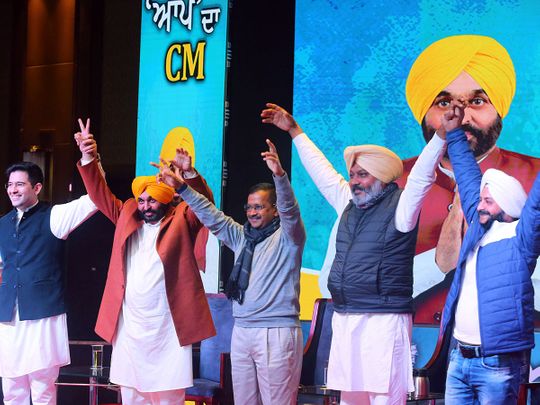
In Amritsar’s Maqboolpura area, I enter a lane and find an elderly Sikh man sitting on a plastic chair on his homestead. I ask him about the most keenly watched contest in Punjab: Sidhu versus Majithia. The Congress party’s Navjot Singh Sidhu is battling his turf, the Amritsar East constituency, against the mighty and much feared Bikram Singh Majithia of the Akali Dal.
Why don’t you come in and have some tea, says the old man. I tell him I don’t have time for tea, I have to speak to a lot more people. But he insists I come in. His body language says he wants to say something in confidence.
We go in, he gives me another plastic chair to sit on, and proceeds to explain where we are sitting. This lane, he says, has around 50 houses. At least ten of those sell drugs. Just a few minutes before I arrived, he says, the parents of a young man came to pick a fight with one drug seller who had sold drugs to their son in exchange of his two-wheeler.
The drug sellers are often taken away by the police but they return in no time, he says. He resents having to live in such an area.
He says the Congress had promised to get Punjab rid of drugs but has failed to do so. While the drugs menace became widespread during the Akali Dal years, he says parties make money off it.
Channi versus Chadu
The gentleman doesn’t even like to take the name of the Akali Dal candidate in this constituency, Mr Majithia, who is battling court charges. He denies all accusations. “The contest is between Charanjit Singh Channi and Chadu,” he says, refusing to name even the Congress candidate, Navjot Singh Sidhu. Chadu, in case you are wondering, is how Punjabis pronounce jhadu or broom, the symbol of the Aam Aadmi Party.
He names Channi because he is from the same Dalit caste. As for Sidhu, he’s never available to his voters. We go to his bungalow and are turned away, he complains.
It takes him no time to make it clear he is going to vote for the Aam Aadmi Party. The lane is full of flags of the Congress and the Akali Dal. At the entry to the lane, Akali Dal supporters sit on a stall. There is no poster, no flag, not even a sticker of the Aam Aadmi Party. Its candidate, a woman named Jeevan Jyoti Kaur, is hardly known to anyone. But this is not an election of candidates. This is an election of change.
Even in this constituency with its high-profile contest between Sidhu and Majithia, you can’t miss the Aam Aadmi Party wave. The party claims both Sidhu and Majithia will lose and AAP will win this election.
We will know on 10 March who wins this seat, but this writer can say with certainty it is a three-corner contest. Some said the vote for AAP is a ‘silent’ one, amid the Sidhu-versus-Majithia noise.
The holy, historic border district of Amritsar is part of the Majha region of Indian Punjab. This region has 25 seats in the state assembly. The other two regions are Doaba and Malwa. Historically, any party that wins the state wins 2 of the three regions. Nobody wins all three.
Why 2022 is not 2017
In 2017, the Congress won 23 of 25 seats in Majha. This time, if even in Sidhu’s own constituency you can sense an AAP wave, it is clear that AAP is poised to win the state. The Malwa region with its 69 seats, is anyway an AAP stronghold, with its chief ministerial candidate Bhagwant Mann himself from Sangrur district.
A lot of people are sceptical of Aam Aadmi Party winning this election since there was also an AAP wave in 2017. However, in the last 15 days or so, the direction of the election wind changed and Congress won the state handsomely.
History, however, has no obligation to repeat itself. There are several reasons why 2022 is not 2017. For one, the Aam Aadmi Party made several mistakes in 2017 that it has not made this time. In 2017, the AAP happily projected itself as wooing the most orthodox sections of the Sikh community.
This time, AAP supremo Arvind Kejriwal is projecting himself as a good Hindu. More importantly, the AAP has learnt the need to do a balancing act between the three main communities: Sikhs, Hindus, and Dalits. Its posters have a Hindu face (Kejriwal), a Dalit face (Harpal Singh Cheema) and a Jatt Sikh CM candidate (Bhagwant Mann). This is a tried and tested winning formula in the state.
Another reason why 2022 is not 2017 is that the Congress is a house in disarray. Its Jatt Sikh face, Sidhu, has been reduced to a caricature. It has a popular Dalit chief minister who has been undermined by Sidhu. Many non-Dalits are not excited by the thought of a Dalit chief minister, though no one will say it openly. The Congress’ Hindu face, Sunil Jakhar, is openly sulking.
In 2017, the Congress had a united face in Amarinder Singh who was projected as a tried-and-trusted leader against a newbie, suspicious Aam Aadmi Party that wouldn’t reveal its CM candidate. This time they have declared the acceptable face of Bhagwant Mann as CM candidate.
Every election has its own dynamic. This time, Aam Aadmi Party has ticked all the boxes, played safe. Their time may have finally come.










